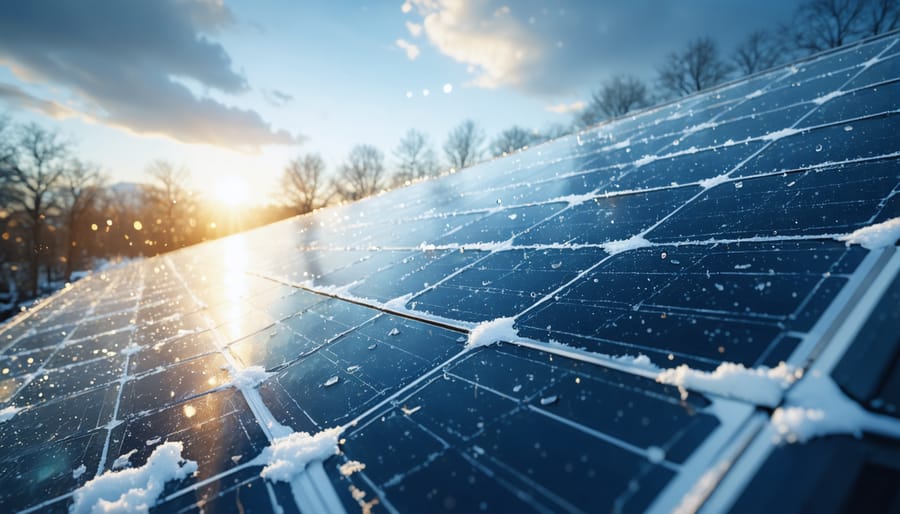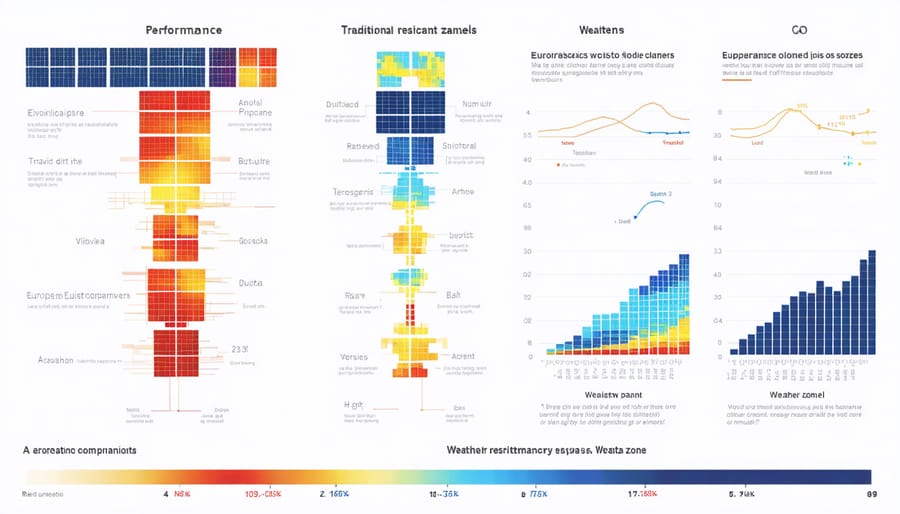These Weather-Proof Solar Panels Keep Performing When Others Fail

Solar panel technology has made remarkable strides in weather resilience, with the latest generation of photovoltaic systems delivering up to 30% more energy output in challenging conditions compared to their predecessors. Advanced polymer coatings now shield panels against hail impact forces of up to 100 km/h, while innovative self-cleaning surfaces incorporating hydrophobic nanotechnology significantly reduce maintenance needs and performance degradation from dust and debris. These improvements directly address Europe’s diverse climate challenges, from Nordic snow loads to Mediterranean sand exposure.
European manufacturers have pioneered smart panel designs that automatically adjust their operational parameters based on real-time weather data, ensuring optimal performance across seasons. Integration with sophisticated monitoring systems allows precise tracking of panel health and efficiency, enabling predictive maintenance before weather-related issues impact energy production. For homeowners and businesses alike, these technological advances translate into more reliable energy generation and substantially lower maintenance costs over the system’s lifetime.
How Weather Impacts Traditional Solar Panels
Temperature Fluctuations
Temperature variations significantly influence how weather affects solar panel performance. While modern solar panels are designed to operate in diverse climates, extreme temperatures can impact their efficiency. During intense heat waves, panel efficiency typically decreases by 0.3-0.5% for every degree above 25°C. Conversely, very cold conditions can actually enhance performance, as panels operate more efficiently in cooler temperatures, though snow accumulation presents its own challenges. Today’s enhanced solar technologies incorporate temperature-resistant materials and innovative cooling systems, maintaining optimal performance between -40°C and 85°C. This broad operating range ensures reliable energy production throughout Europe’s varying seasonal conditions, from Mediterranean summers to Nordic winters.
Moisture and Precipitation
Modern solar panels are engineered to withstand various moisture conditions while maintaining optimal performance. High-quality panels feature robust sealing and protective glass layers that effectively shield the photovoltaic cells from rain and snow. Most installations can endure humidity levels up to 85%, and some advanced models incorporate hydrophobic coatings that encourage water to roll off, simultaneously cleaning the surface.
Snow accumulation typically slides off panels due to their tilted installation angle and the heat they generate during operation. In regions with heavy snowfall, specialised mounting systems can be adjusted for steeper angles to prevent snow build-up. Additionally, contemporary panels undergo rigorous weather testing, including freeze-thaw cycles and humidity-heat exposure, ensuring durability in diverse European climates.
For maximum longevity, manufacturers now implement enhanced edge sealing and reinforced junction boxes, protecting crucial components from moisture intrusion. These improvements have extended the typical lifespan of panels to 25-30 years, even in areas with significant precipitation.

Wind and Physical Stress
Modern solar panels are engineered to withstand significant wind loads of up to 2400 Pascal (equivalent to 140 km/h winds). Advanced mounting systems and reinforced frames distribute physical stress evenly across the panel surface, preventing warping and microcracks. European testing standards ensure panels maintain optimal performance even in regions prone to strong coastal winds or heavy snow loads, offering peace of mind for long-term installations.

Advanced Weather-Resistant Features
Enhanced Frame Design
Modern solar panel frames have evolved significantly, incorporating advanced aluminium alloys and innovative structural designs that enhance both durability and installation flexibility. The latest generation of frames features reinforced corner joints and integrated water drainage channels, effectively preventing moisture accumulation and reducing the risk of corrosion. These improvements have extended panel lifespans by up to 30% compared to traditional designs.
European manufacturers have pioneered smart mounting systems that allow for rapid installation while maintaining exceptional structural integrity. These systems include adjustable clamps and pre-assembled components that reduce installation time by approximately 40%. The new frame designs also accommodate various roof types common across European architecture, from steep Alpine slopes to Mediterranean tile roofs.
Weight optimization has been another crucial advancement, with newer frames being 25% lighter while maintaining superior strength. This reduction in weight not only eases installation but also decreases the structural load on buildings. Additionally, innovative anti-theft features have been integrated into modern frames, addressing a growing concern among solar installation owners.
The frames now include built-in cable management systems and grounding points, ensuring safer electrical connections and simplified maintenance procedures.
Advanced Material Science
Recent breakthroughs in advanced materials in solar panels have revolutionised their durability and performance. New generation panels feature specialised anti-reflective coatings that not only maximise light absorption but also provide superior protection against environmental elements. These coatings incorporate hydrophobic properties that enable self-cleaning capabilities, reducing maintenance needs while maintaining optimal efficiency.
Innovative polymer encapsulation materials now offer enhanced UV resistance and thermal stability, extending panel lifespan beyond traditional expectations. The integration of nano-engineered materials has improved the panels’ resistance to micro-cracks and thermal stress, common issues in harsh European climates.
Particularly noteworthy is the development of reinforced glass technologies incorporating cerium oxide, which provides exceptional durability against hail impact and extreme temperature fluctuations. These materials maintain their structural integrity while allowing for lighter panel designs, making installation easier without compromising strength.
The latest protective backsheets utilize multi-layer fluoropolymer composites, offering superior moisture protection and thermal regulation, crucial for maintaining consistent performance across varying weather conditions.
Smart Weather Protection Systems
Modern solar panels now feature sophisticated weather protection systems that actively monitor and respond to environmental conditions. Advanced sensors track temperature, precipitation, wind speed, and atmospheric pressure, enabling automatic adjustments to maintain optimal performance. These smart systems can tilt panels to shed snow, adjust positioning during storms, and even trigger protective measures against hail damage.
Integrated weather stations communicate with central control units, providing real-time data that helps predict and mitigate weather-related risks. Some systems incorporate heating elements to prevent snow accumulation and ice formation, while others feature automated cleaning mechanisms that activate during dusty conditions. This proactive approach to weather protection significantly extends panel lifespan and maintains consistent energy production throughout the year.
The latest European installations demonstrate up to 30% better performance during adverse weather conditions compared to traditional static systems, making these smart protection features an increasingly essential component of modern solar installations.
Real-World Performance Data

Performance in Northern Europe
Recent studies from Nordic countries have demonstrated remarkable advances in solar panel performance under challenging weather conditions. In Norway, a 2022 pilot project featuring enhanced solar panels showed consistent energy production even during the darkest winter months, achieving up to 60% of their rated capacity on clear winter days. The success stems from improved photovoltaic materials that better capture diffused light and anti-reflective coatings that maximize sunlight absorption in low-light conditions.
Finland’s VTT Technical Research Centre documented a 25% increase in energy yield from new-generation panels compared to conventional models, particularly during snow conditions. The improved designs incorporate sophisticated snow-shedding surfaces and robust frame structures that withstand heavy snow loads up to 5,400 Pa. Additionally, Swedish installations near the Arctic Circle have reported steady performance through temperature fluctuations from -30°C to +25°C, thanks to enhanced thermal management systems.
These developments have sparked increased adoption across Northern European regions, with Denmark recording a 40% growth in solar installations during 2021-2022, primarily utilizing these weather-resistant technologies.
Mediterranean Climate Results
Testing conducted across multiple Mediterranean installations demonstrates impressive performance gains in the latest generation of solar panels. Data collected from sites in Southern Spain, Greece, and Italy shows average efficiency improvements of 12-15% compared to traditional installations, even during peak summer temperatures.
In Portugal’s Algarve region, a large-scale commercial installation reported maintaining 94% efficiency despite ambient temperatures reaching 38°C, thanks to advanced thermal management systems. Similar results were observed in Sicily, where innovative panel coatings helped reduce heat-related performance losses by up to 8%.
Greek installations along the coastline have shown particular resilience to salt air exposure, with degradation rates 30% lower than previous-generation panels. This enhanced durability translates to extended system lifespans, with projected operational lives exceeding 25 years under Mediterranean conditions.
Recent data from Valencia, Spain, indicates that bifacial installations are achieving up to 20% higher annual energy yields compared to conventional panels, particularly in areas with high ground reflectivity. These results underscore the significant advancements in solar technology specifically optimized for Mediterranean climates.
Installation and Maintenance Considerations
Proper installation and regular maintenance are crucial factors in ensuring optimal solar panel durability and performance. When installing improved solar panels, professionals should conduct thorough site assessments to determine the ideal mounting angle and orientation, typically between 30-45 degrees in most European locations. This optimises exposure while allowing rain and snow to naturally slide off the panels.
To enhance weather resistance, installers must properly seal all mounting points and cable entry locations using high-grade weatherproof materials. The mounting structure should include adequate spacing between the roof and panels (typically 10-15cm) to ensure proper ventilation and prevent moisture accumulation.
Regular maintenance routines should include:
• Quarterly visual inspections for physical damage or debris
• Bi-annual professional cleaning using soft brushes and appropriate cleaning solutions
• Annual electrical performance checks
• Inspection of mounting hardware and sealants every two years
• Monitoring system checks to ensure optimal performance tracking
During winter months, snow removal should be handled carefully to avoid panel damage. Most modern installations include snow guards and heated elements to facilitate natural snow shedding. For coastal installations, additional protective measures against salt corrosion are essential, including marine-grade mounting hardware and enhanced coating systems.
Professional maintenance contracts often include automated monitoring systems that alert owners to performance issues before they become critical. This proactive approach helps maintain efficiency levels and extends the system’s operational life, making it a worthwhile investment for long-term sustainability.
Weather-resistant solar panels represent a significant leap forward in renewable energy technology, offering European property owners and businesses a reliable path to sustainable power generation. These advanced panels demonstrate remarkable resilience against diverse weather conditions, from heavy rainfall and hailstorms to extreme temperatures and snow loads, ensuring consistent energy production throughout the year.
The enhanced durability and performance of modern solar installations translate into tangible benefits: reduced maintenance costs, longer system lifespans, and more stable energy output. For European markets, where weather patterns can be particularly challenging, these improvements make solar energy an increasingly attractive investment for both residential and commercial applications.
As we move towards a more sustainable future, weather-resistant solar panels play a crucial role in building resilient energy infrastructure. Their ability to maintain high performance levels despite adverse weather conditions supports the European Union’s renewable energy goals and helps reduce dependency on conventional power sources.
These technological advancements, combined with improving efficiency rates and decreasing installation costs, position weather-resistant solar panels as a cornerstone of our renewable energy future. For property owners and businesses considering solar adoption, these innovations offer the perfect balance of durability, reliability, and long-term value.
Leave a Reply